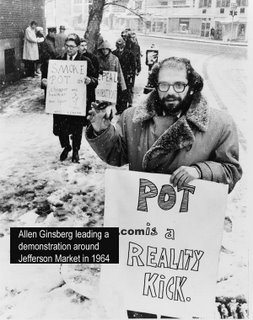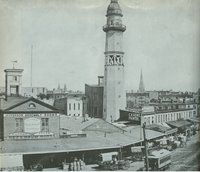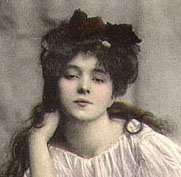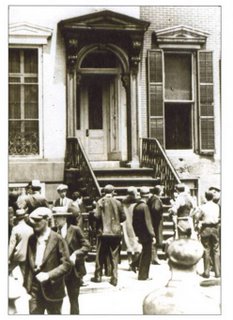Greenwich Village's respected weekly newspaper,
The Villager, published an EDITORIAL that posed a question. First, here's a reprint of their inquiry - - and Old Jeff's response is directly below.
The Villager [Vol. 75, No. 35 | January 18 - 24, 2006
• • • •
Editorial: • • • •
Why must we choose outside vs. inside at Jefferson Library?• • One of Greenwich Village’s
most distinctive and beautiful buildings, the
Jefferson Market Library on Sixth Avenue has stood with its exterior shrouded in scaffolding for
nearly three years.
Last year the community got wind of a New York Public Library proposal to do an extensive interior renovation and also add a new teen lounge to the library — this even as the exterior is sorely needing of repairs.
• •
The overwhelming sentiment of local residents at public meetings on the library is that they don’t want a separate teen lounge to bump the research room out of the library’s basement floor or shrink the research area’s space. Many Villagers and others value this downstairs space as a quiet spot to do research, look at microfilm or just read undisturbed in peace. The library’s research facilities are valuable to writers and other researchers and the quiet is appreciated by those who are searching for some tranquility in a cacophonous, always-bustling city. This basement with its Gothic archways has its aesthetic charm too.
• • Since
The Villager first reported the teen lounge plans 8 months ago, the plans have evolved somewhat. Initially, library officials said the lounge might have more comfortable furniture, times when music is played, and a TV set that plays music videos. Teen lounges are a national trend to attract youth to libraries, they said. They are popular in Los Angeles and there is already one in the Donnell Library on W. 53rd St.
• • However, at a Village Independent Democrats meeting last week, a library official described the prospective Jefferson Market Library teen lounge as a space with books and computers that, while designated for young adults, will be open to all users.
• • At times, the debate has resembled an intergenerational conflict, with some residents saying the youth don’t need a segregated area but should integrate with “
the population” and that a separate youth space will create a racket.
• • While discussion of the
teen lounge continues,
the fact remains that the library’s exterior, its limestone trim and gargoyles, desperately needs repair and that pieces of it are at risk of falling — hence the scaffolding.
• • Council Speaker Christine Quinn is looking into whether the $2.1 million the Council allocated for the interior renovations — about two-thirds of the total cost — can be switched to the exterior renovation.
• • It seems absurd, though, that we must choose between interior or exterior.
Why can’t we do both? Clearly, this landmarked 1877 building’s exterior must be renovated and that unsightly shed removed as quickly as possible. As for the teen lounge, we’d like to hear more about it, in terms of programming and staffing, for example. Will this prospective lounge be a hangout or a place teenagers can fill their minds with knowledge and sharpen literacy skills?
• • Villagers rallied to save this historic building and convert it to a library in 1967. Let’s not let it crumble now. The funding has to be there somewhere.
___ ___
• • • •
Old Jeff Responds • • • •
When people have demonstrated an
ongoing lack of integrity and a
lack of respect, who would trust these folks to do the right thing? By their approach, Susan C.Y.A. Kent and her ilk have
offended and
alienated this community. At this point, a discussion of INTERIOR renovations [- - which might include a 36-inch-TV in a new Teen Lounge, and ear-splitting music videos, two prominent features in the Donnell Library's Teen Central on West 53rd St. - - ] would not even be possible until the NYPL shows good faith by restoring the EXTERIOR and removing that wooden sarcophagus.
• • • • YES, one of Greenwich Village’s most distinctive and beautiful landmarks, the Jefferson Market Library on Sixth Avenue, has stood with its exterior shrouded in a sidewalk bridge (paid for by NYC taxpayers) for nearly three years. WHY? Because the exterior is crying for repairs.
• • • • YES, the 19th century Venetian Gothic facade is so badly damaged because the
NYPL neglected it for decades. [In the 1960s, the NYPL only wanted the
site -- so that they could erect a new building.]
• •
Lack of respect: their initial rejection of our 19th century building.
• •
Lack of integrity: their profound neglect of the facade has caused interior leaks. If you're truly a book-lover, how do you feel about water damage?
• •
Reaction: "Damage to the exterior of the building is noticeable indoors," says Cynthia Crane Story, a preservationist, "with a detectable odor of urine and mold. Imagine a mold infestation taking hold, the unimaginable costs to a library - - a building full of paper."
• • • • YES, the overwhelming sentiment of local residents at public meetings on the library is that fixing the FACADE comes first - - and this repair is way overdue.
• •
Lack of respect: During an autumn meeting attended by over 100 local residents, NYPL representatives coolly informed attendees that it intended to forge ahead and may close the library for extended periods - - despite the community's nearly unanimous disapproval of their plans.
• •
Lack of integrity: Scrutiny suggests that the trustees and fat-cat executives of the New York Public Library [trading on their "public" name and the goodwill that comes when citizens believe an institution really cares about the city's underprivileged], in fact, preside over a well-oiled system designed to ensure that the proceeds of their glamourous fundraisers and the gifts of generous donors will NOT trickle down to the branch libraries.
• •
Lack of integrity: Even as the NYPL applies for more funding from the City for this new "teen lounge" trend, the NYPL is
decreasing their number of young-adult librarians! There are only 48 young-adult librarians in the system, down from 81 in 1995, said Debbie Bujosa, a library spokeswoman [in a recent N.Y. Times interview]. Think about it. . . .
• •
Lack of integrity: Greenwich Villagers, proud of the area's literary history, view their library as a book zone, a place for reading. When Kent pushes for a library lounge aimed at teenagers that has
little to do with reading, and more to do with music-video viewing or TV watching, there's no BOOK on her hook. Sounds like an attempt to turn a library into a Starbucks.
• •
Reaction: GVBA spokesperson Marilyn Dorato complained in a letter to NYPL President Paul LeClerc that, at an October 18th community meeting at Jefferson Market Library, "both NYPL representatives and CB2 members treated residents’ concerns with disdain and derision." Instead of replying, however, LeClerc passed Dorato's letter to Susan C.Y.A. Kent, who sent her standard see-no-evil missive. Retch!
• • • • YES, the funding has to be there somewhere. . . but Jefferson Market will not see any of it.
• •
Lack of respect: In 2004, the NYPL's total revenue reported to the IRS was a healthy number: $219,605,726. To comprehend why neighborhood libraries struggle for survival while their parent institution sits on a gilded stockpile of tax-free donations, you need to understand a basic truth. The NYPL is, in fact,
two systems with
two budgets: The 80 branches, which circulate materials, receive only 7 percent of their funds from private sources, with the rest coming from city, state, and federal agencies. NYPL's five non-lending research libraries receive the lion's share of private gifts. Consequently, whenever the city reduces its funding to the NYPL, only the neighborhood branches will feel the pinch.
• •
Lack of integrity: Though the librarians' union has repeatedly asked NYPL to protect jobs and branch services by tapping into the corporation's endowment, each president has stated that he [it's always a HE!] will not do it. Consistently, the NYPL's board of trustees has refused to use the endowment to compensate for New York City cuts, pointing to a 1901 agreement by which Andrew Carnegie agreed to build 65 branch libraries for New York City on the condition that the city would maintain and operate the branches in perpetuity. YES, that is correct. As New York City has grown and new branch libraries have been added, the Carnegie principle is a convenient fall-back position. "We are afraid that if we start replacing public money with private money, the city will relinquish its responsibility for operating the branch library system," explained one NYPL spokesperson. So did you understand that? The NYPL is willing to deprive New York's neighborhood branch libraries if that's what it takes to make NYC honor its side of the 1901 agreement. If the NYPL can screw their own librarians, can a Greenwich Village library expect much better?
• •
Lack of integrity: What happens when, for instance, an unrestricted $10.5 million donation arrives in the mail? Instead of reversing the deterioration of a branch library's facade, the $$$ swan-dives into NYPL's well-feathered nest. An issue of CFO magazine, which profiled an NYPL Vice President for Finance, applauded the library's finance expert for the foxy bookkeeping he employed when an anonymous lamb sent the no-strings-attached check. Here's the dirty secret: The NYPL would enter the $$$ on a separate line as a bequest and stash it immediately into the endowment from which the library will draw investment earnings.
• •
Reaction: "That's almost an outrage, isn't it?" asked the editor-in-chief of
Library Journal, a Manhattan-based trade magazine. "It's bizarre thinking, and I'm not sure how they justify it, but they have repeatedly received gifts from donors who say, 'The library saved my life,' and it turns out it is a library in downtown Manhattan - - yet the money goes to the 42nd Street research library ONLY."
• • Whose fault is this? The fault, dear neighbors, is not in our stars, but in ourselves, that we are
underlings - - and they are
fat cats.
• • How FAT are the NYPL fat cats? In 2004, the annual compensation for Paul LeClerc, NYPL President, was $487,819. [The compensation for LeClerc is equal to 0.20% of the NYPL's total functional expenses.] In 1989, IRS documents reveal that NYPL President Vartan Gregorian, working only 10 months, earned $247,469 in salary and bonuses, i.e., nearly twice what New York's governor made in 1989. In 1988, Vartan Gregorian's $37,570 benefit package alone was more than the starting salary of a supervising branch librarian [in 1988]. YES, yes, $300,000 was about the same as the cost of running the Jefferson Market branch for 12 months during the 1980s.
• • A sarcophagus "eats flesh" - - which is why Greenwich Villagers must pressure elected officials to help remove that wooden sarcophagus which is damaging Jefferson Market. Write the letters, make the phonecalls, make noise, and do whatever it takes to rescue our beloved landmark imprisoned since 2003 by the neglectful top brass at NYPL.
___ ___
Source:http://jeffersonmarketcourthouseny.blogspot.com/atom.xml
 Jefferson Market
Jefferson Market• • Photo: • to come
NYCNew York Public LibraryJefferson Market.
















